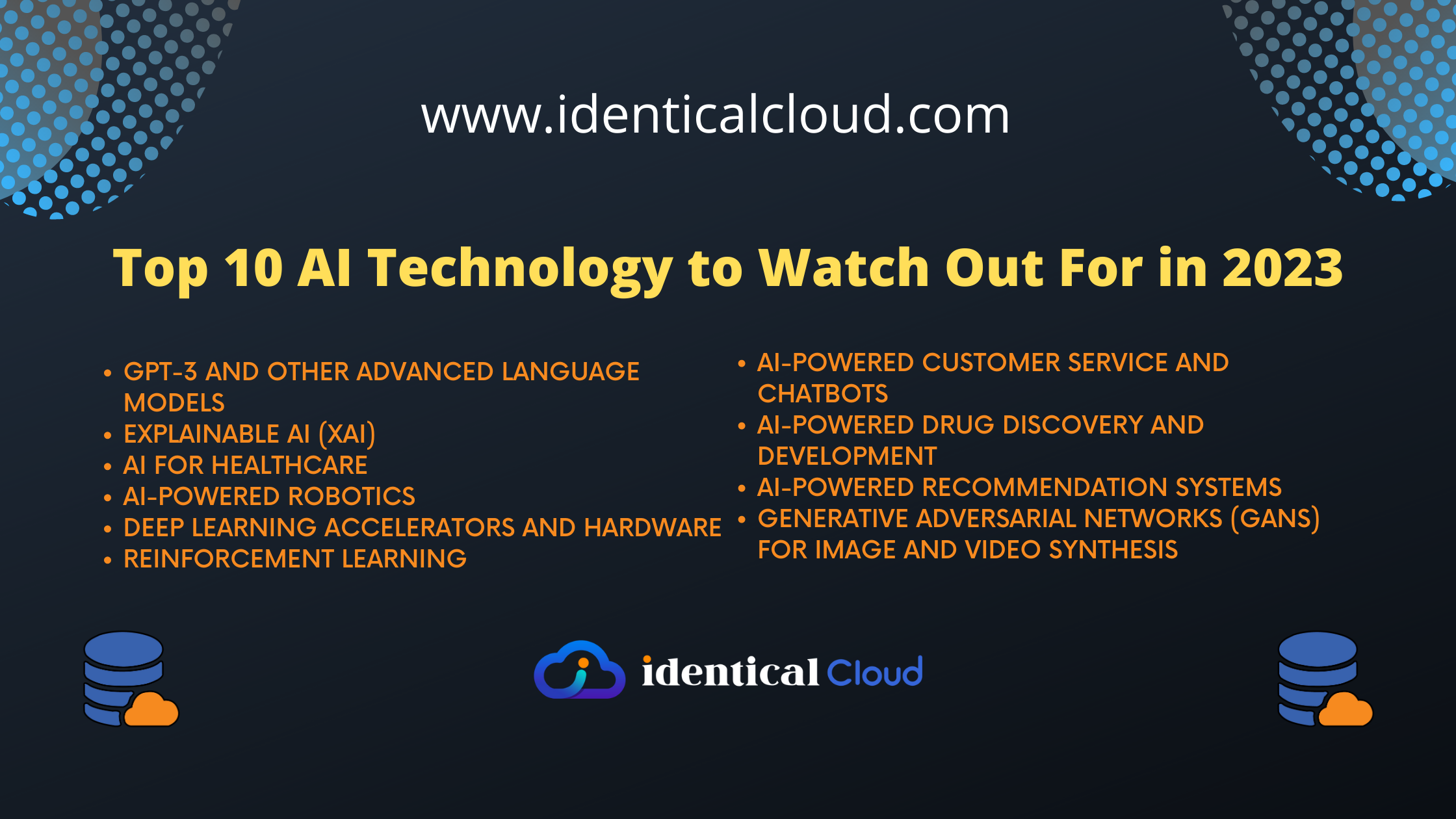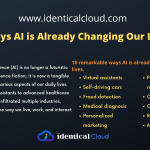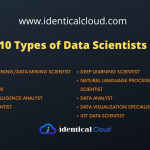
Top 10 AI Technology to Watch Out For in 2023
Artificial Intelligence is coming up with something new day by day! AI technology has certainly made things easier for us. There’s a lot more to AI technology than natural language generation and stuff.

AI Technology to Watch Out For in 2023
Here are some AI technologies that are expected to be significant in 2023:
- GPT-3 and other advanced language models:
Language models like OpenAI’s GPT-3 have already demonstrated the ability to generate human-like text and carry out tasks such as translation and summarization. We can expect these models to become more capable and accessible in 2023, leading to new applications in areas such as chatbots, customer service, and content generation. - Explainable AI (XAI):
There is growing concern about the lack of transparency in AI systems and the need for systems that can provide understandable and verifiable explanations for their decisions. XAI aims to address this by developing AI systems that are interpretable, accountable, and transparent, and this is expected to become a critical area of research and development in 2023. - AI for healthcare:
AI has the potential to transform healthcare by improving diagnosis, treatment planning, and drug development. In 2023, we can expect to see continued progress in this area, including the development of new AI-powered tools for medical imaging analysis, personalized medicine, and population health management. - AI-powered robotics:
AI-powered robots are expected to become more capable and widely used in 2023, especially in industries such as manufacturing, logistics, and warehouse management. These robots will have the ability to perform complex tasks and make decisions, enabling new levels of automation and efficiency. - Reinforcement learning:
Reinforcement learning is a type of machine learning that trains AI agents to take actions in an environment to maximize a reward signal. This technology is expected to play an increasingly important role in 2023, especially in areas such as autonomous systems, robotics, and games. - Deep learning accelerators and hardware
Deep learning accelerators and hardware refer to specialized hardware designed specifically to accelerate deep learning tasks, such as training and inference of deep neural networks. These accelerators can significantly reduce the time and computational resources required for deep learning tasks, making it possible to carry out these tasks in real-time or near real-time.
Some examples of deep learning accelerators and hardware include GPUs (graphics processing units), TPUs (tensor processing units), and custom ASICs (application-specific integrated circuits). These hardware devices use parallel processing and optimized algorithms to speed up the matrix computations that are the core of deep learning.
In 2023, we can expect to see continued development and improvement in deep learning accelerators and hardware, as well as the availability of new products and solutions. This will likely lead to increased adoption of deep learning for real-world applications and could have a significant impact on the speed and efficiency of deep learning tasks. - AI-powered customer service and chatbots
AI-powered customer service and chatbots are expected to become more sophisticated and widespread in 2023. These systems use natural language processing and machine learning algorithms to automate customer service interactions and provide quick and accurate answers to customer questions.
In 2023, we can expect AI-powered customer service and chatbots to continue to improve in their ability to understand and respond to customer inquiries, leading to better customer experiences and higher levels of customer satisfaction. AI-powered chatbots will likely become more human-like in their ability to carry out conversations and handle complex queries, reducing the need for human intervention in many customer service scenarios.
Additionally, the use of AI-powered chatbots for customer service is expected to increase as businesses look for ways to reduce costs and improve efficiency. AI-powered chatbots can provide 24/7 availability, fast response times, and consistent answers, all of which can result in improved customer experiences and increased customer loyalty.
Overall, AI-powered customer service and chatbots are expected to be a major technology trend in 2023, as businesses continue to adopt and invest in AI solutions to improve their operations and customer experiences. - AI-powered drug discovery and development
AI-powered drug discovery and development is expected to become a significant trend in 2023, as more pharmaceutical companies adopt AI technologies to improve their research and development processes. AI has the potential to accelerate and optimize the drug discovery process by analyzing large amounts of data, identifying new targets for drug development, and predicting the efficacy and safety of potential drugs.
In 2023, we can expect to see continued progress in the use of AI for drug discovery and development, including the development of new AI-powered tools for molecular modeling, lead optimization, and toxicity prediction. AI can help to reduce the time and costs associated with traditional drug discovery methods, and could lead to the discovery of new treatments for a variety of diseases.
Additionally, the use of AI in drug discovery and development is expected to increase as more data becomes available and as AI technologies become more accessible and easier to use. This will likely result in the creation of new partnerships and collaborations between pharmaceutical companies and AI researchers, as well as the establishment of new AI-focused startups and spin-offs in the pharmaceutical industry.
Overall, AI-powered drug discovery and development is expected to be a major area of innovation and investment in 2023, as the pharmaceutical industry looks to take advantage of the benefits of AI to improve the speed and efficiency of drug discovery and development. - AI-powered recommendation systems
AI-powered recommendation systems are expected to become even more sophisticated and widely used in 2023. These systems use machine learning algorithms to analyze large amounts of data and provide personalized recommendations to users based on their preferences, behavior, and past interactions.
In 2023, we can expect AI-powered recommendation systems to continue to improve in their accuracy and relevance, leading to better user experiences and increased customer satisfaction. The use of AI-powered recommendation systems is expected to expand across a variety of industries, including e-commerce, entertainment, and finance, as businesses look for ways to improve customer engagement and increase revenue.
Additionally, the use of AI-powered recommendation systems is expected to increase as more data becomes available and as AI technologies become more accessible and easier to use. This will likely result in the creation of new partnerships and collaborations between businesses and AI researchers, as well as the establishment of new AI-focused startups and spin-offs in the recommendation system space.
Overall, AI-powered recommendation systems are expected to be a major technology trend in 2023, as businesses continue to adopt and invest in AI solutions to improve their operations and customer experiences. - Generative adversarial networks (GANs) for image and video synthesis
Generative adversarial networks (GANs) are expected to continue to make significant advancements in the field of image and video synthesis in 2023. GANs are a type of deep learning architecture that use two neural networks, a generator and a discriminator, to generate new data samples that are similar to a given training set.
In 2023, we can expect to see continued progress in the use of GANs for image and video synthesis, including the development of new GAN architectures and the availability of large-scale GAN models. GANs have the potential to revolutionize the fields of computer graphics and video synthesis, allowing for the creation of realistic and high-quality synthetic images and videos.
Additionally, the use of GANs for image and video synthesis is expected to increase as more data becomes available and as GANs become more accessible and easier to use. This will likely result in the creation of new partnerships and collaborations between computer graphics researchers and AI researchers, as well as the establishment of new AI-focused startups and spin-offs in the computer graphics and video synthesis space.
Overall, GANs for image and video synthesis are expected to be a major area of innovation and investment in 2023, as the field continues to advance and as the potential applications of GANs for computer graphics and video synthesis become more widely recognized.
These are just a few examples of the many exciting developments in AI that we can expect to see in 2023. The field is constantly evolving, and new breakthroughs are likely to emerge that could change the landscape of AI in unexpected ways.







